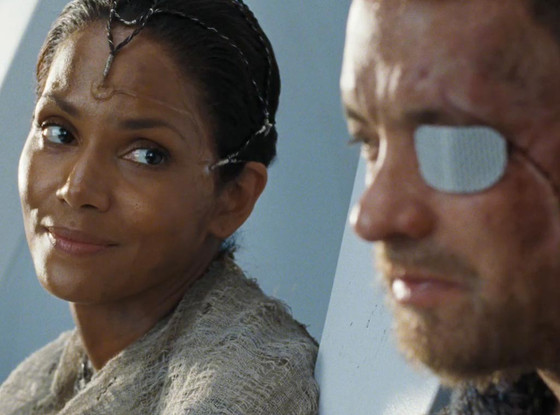(AP) Can ‘Cloud Atlas’ survive Hollywood reincarnation?
By DAVID GERMAIN
AP Movie Writer
LOS ANGELES
Susan Sarandon reported for work on “Cloud Atlas” midway through the shoot, in time to see a collection of far-flung film scenes that the cast and crew were viewing.
There were bits of a 19th century sea voyage, a 1930s period drama, a 1970s thriller, a contemporary comic adventure, a 22nd century tale of rebellion and a 24th century post-apocalyptic saga.
Yet it was just one film: “Cloud Atlas,” an epic of shifting genres and intersecting souls that features Tom Hanks, Halle Berry, Jim Broadbent, Hugh Grant, Hugo Weaving, Ben Whishaw, Jim Sturgess, James D’Arcy, Doona Bae, Keith David, Sarandon and others in multiple roles spanning centuries.
That diverse cast is a great selling point for distributor Warner Bros., which opens “Cloud Atlas” in U.S. theaters Oct. 26. So, too, is the filmmaking team: American siblings Lana and Andy Wachowski, creators of “The Matrix” films, who wrote the screenplay and directed “Cloud Atlas” with German filmmaker Tom Tykwer (“Run Lola Run”).
The fact that the film is adapted from a best-selling novel also should help its audience appeal. Yet considering that “Cloud Atlas” author David Mitchell himself once felt the novel was unfilmable, fans of the book may have serious doubts about handing over their cash and spending nearly three hours in a theater to digest Hollywood’s version.
It’s such a tough sell that even the notoriously media-shy Wachowskis, who had a no-press clause on earlier films, are out there eagerly hawking “Cloud Atlas.”
With mixed but generally appreciative early reviews _ some critics reveling in its audacity and even detractors admiring its ambition _ “Cloud Atlas” already is an artistic success simply by existing, given its unlikely path to the screen.
The Wachowskis discovered the book from Natalie Portman, who was reading “Cloud Atlas” on the set of their 2006 thriller “V for Vendetta.” The siblings recommended the novel to Tykwer, and the three spent years overcoming creative and commercial obstacles to adapt it for film.
The $100 million budget was pieced together from a variety of international financiers and distributors; Warner Bros. acquired U.S. rights but declined to finance the film, despite the studio’s success with the Wachowskis’ “Matrix” trilogy.
Then there were the challenges of condensing dozens of key characters in six stories that span the globe and sprawl across 500 years as souls are reincarnated and progress through the ages.
The way they cracked the code was, in a word author Mitchell tosses about repeatedly, ingenious. The same actors would play characters in different periods, sometimes switching race and gender, as each soul moves upward, downward or sideways on the karmic plane.
So Hanks is a rapacious doctor in 1849, a murderous thug with artistic pretensions in 2012, a cowardly goatherd inching toward enlightenment in the 24th century. Berry is a white Jewish adulteress in the 1930s, a gutsy journalist in the 1970s, an Asian medical man in the 22nd century and part of an elite race of survivors in the 24th.
The film’s prologue is an assault of images and characters introducing six different time periods and stories, with “Cloud Atlas” then settling into a kaleidoscope that shifts from era to era, deconstructing the chronological structure of the half-dozen narratives in Mitchell’s novel.
With the Wachowskis directing the 1849 segment and the two futuristic ones and Tykwer overseeing the 1930s, 1970s and contemporary stories, “Cloud Atlas” could have been a schizophrenic mess.
The actors shuttled from sets in Scotland, Germany and Spain, changing costumes, characters and directors from day to day.

COMMENTS
Please let us know if you're having issues with commenting.